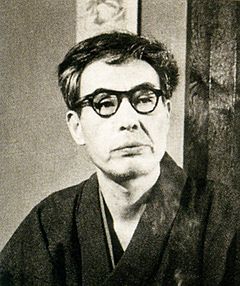- Nakayama Gishu
-
Nakayama Gishū 
Nakayama GishūBorn 5 October 1900
Shirakawa city, Fukushima Prefecture, JapanDied 19 August 1969 (aged 68)
Kamakura, Kanagawa prefecture, JapanOccupation Writer Genres historical novels, short stories
Influences- Yokomitsu Riichi
In this Japanese name, the family name is "Nakayama".Nakayama Gishū (中山 義秀, 5 October 1900 – 19 August 1969) was the pen-name of a Japanese writer active in Showa period Japan. His real name was Takama Yoshihide.
Contents
Early life
Gishū was born in what is now Shirakawa city, Fukushima Prefecture, and was a graduate of Waseda University. During and after his time in the university, he taught English language in local middle schools.
Literary career
While a student at Waseda, Gishū founded a literary magazine, To ("Tower") together with Yokomitsu Riichi and others, to which he contributed his first story, Ana ("The Hole").
In 1938, he published his first short story collection, Denko ("Electric Light"), and two years later, won the 7th Akutagawa Prize for his novelette Atsumonozaki (厚物咲). These works were followed by the short stories, Ishibumi ("Monument"), Seifu Sassa ("Swift Breeze") and Fuso ("Wind and Frost"), which secured his reputation in the literary world.
Gishū moved to Kamakura, Kanagawa prefecture, from 1943 to the end of his life and took an active interest in the lending library, Kamakura Bunko, and the publishing house of the same name.
His experiences as a war correspondent in World War II led to the short story Teniyan no matsujitsu in 1948, about two young intellectuals who died on Tinian in the Mariana Islands towards the end of the war. This marked a new start for Gishu, who later concentrated on historical novels, with the main subject being historical figures fighting for lost causes. These works include Shoan, about the 16th century warrior Akechi Mitsuhide, which won the Noma Prize in 1964, and the Japan Art Academy Prize in 1967.
Gishū died of acute anemia in 1969. Shortly before his death, he converted to Christianity; however, his grave is at Shorei-in sub-temple of the Zen-sect temple of Engaku-ji in Kamakura.
Prizes
- 1938 Akutagawa Prize---Atsumonozaki,『厚物咲』[1]
- 1964 Noma Literary Award---Sakuan,『咲庵』
- 1966 Award of the Japan Art Academy---Sakuan,『咲庵』
See also
- Japanese literature
- List of Japanese authors
External links
References
- ^ "芥川賞受賞者一覧" (in Japanese). Bungeishunjū. http://www.bunshun.co.jp/award/akutagawa/list1.htm. Retrieved 2010-01-27.
- Kiyohara, Yasumasa. Nakayama Gishu no shogai. Shin Jinbutsu Oraisha (1993). ISBN 4404020244 (Japanese)
- Mikame, Tatsuji. Nakayama Gishu no rekishi shosetsu. Shintensha (1993). ISBN 478796755X (Japanese)
Categories:- 1900 births
- 1969 deaths
- Japanese writers
- Japanese short story writers
- Japanese novelists
- Japanese Christians
- People from Fukushima Prefecture
- Waseda University alumni
- Winners of the Akutagawa Prize
- Deaths from anemia
Wikimedia Foundation. 2010.
